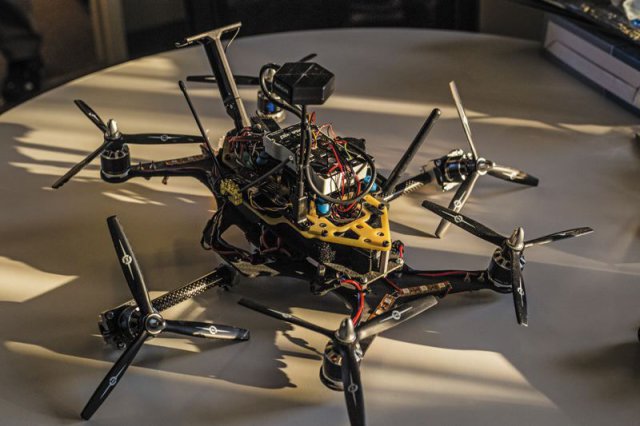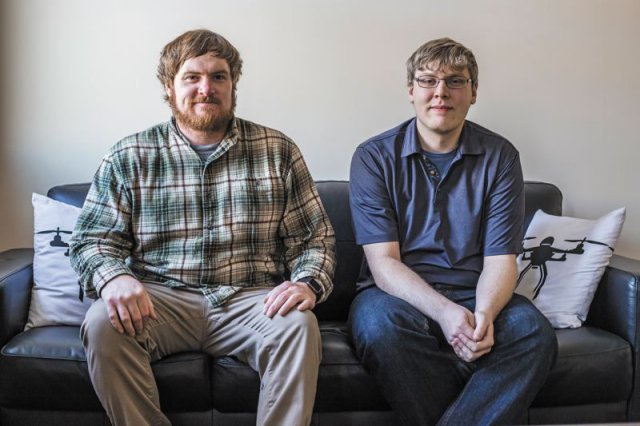
Aeronautical engineer Dan Bosch was sitting around with his buddies Tom Brigham and Neil Puri talking about ways to improve unmanned aerial vehicles. The fixed wing kind are fast (over 100 mph) and economical, but can’t carry much of a payload and are bad at hovering. The rotor type, with four or six rotating blades, have great lift and hover well but are slow, topping out at around 40 mph.
Drawing with pencil on paper they hit upon an idea. Make one of the arms of a six-rotor Hex copter swivel, so that the rotors on either end can tilt. That would give thrust and improve maneuverability — perfect for commercial use, where firefighters need to scope out hotspots and winemakers need to hover over vines analyzing leaves for blight.
It worked.
The prototype they came up with looked like three black poles formed into an asterisk, with the crucial difference that with the tiny sound of a servo motor, one of the carbon fiber poles does indeed turn, angling the blades. Bosch is in Northwest Portland while Brigham remains at his job with G.E. Aviation in Boston and Puri in San Diego, but they still work together remotely.
SICdrone successfully applied to be in the Jaguar Land Rover Tech Incubator in at 1450 N.W. 18th Ave., and Bosch relocated to Portland in April 2016.
“It’s a six month program but they (JLR) told us from the beginning they’d probably keep us around for a while.”
Now hiring
JLR has a 10 percent stake in SICdrone, as is usual, offering rent-free space and access to its engineers and mentors. When the six-month stint ended in the fall, most of the interns went back to school and SICdrone ramped back down to two in the Portland office: Bosch, 38, and Alex Michel. They are hiring again, and looking for grants, and hope to be up to a dozen staff by summer.
Twenty-four-year-old Michel is a recent University of Portland graduate in electrical engineering. He knows his C, C+ and Java as well as “a few of the more obscure languages.” His task is to program the flight controller.
This is a small, $200 black box covered in ports which is programmed to tell the rotors how to perform.
On a recent January morning, Michel was sitting at his desk working on a page of code. The flight controller looks like an arduino. It sits on his desk with other clutter, such as a Nikon sport camera and various wires and pop cans.
“The twisting has been manual up until now, so we know the Hex flies well,” he says of the drone’s unique rotational arms. “Now we’re working on making it automatic. I’m teaching the PixHawk (flight controller) how to fly with the adjustable arms.” He says first they make it fly with it always rotating, then they give it “situational awareness” so it can make decisions.

SIC CEO Dan Bosch (left) and Software Engineer, Alex Michel.
Jonathan House – Portland Tribune Photos
Stack
Michel is basically teaching the tiny computer to vary the pitch, yaw and roll of the drone in real time and in changing conditions (wind). For now he writes code then tests the ideas on a simulator.
The basic open source code is the PX4 Flight Stack, which is free flight control software made by some graduate students in Germany for different types of drones.
“They allow us to fork it and make changes, I can create my own branch,” he says, explaining forking.
Bosch chips in that the work they do will be their own, not open source, and will become an asset like the patent pending for their rotating rotor arm.
This is my fourth month working on it,” says Michel. “I’ve gotten far, I have gotten it to wiggle but I haven’t got to the point where I feel confident flying it.”
In the Navy
One way of testing is to tie the drone to the ground inside the office and gun the motors, or do it with the motors off. The goal is to make sure the software and hardware make the most of the aeronautical breakthrough, before taking it out to private land on Sauvie’s Island or to the official tests sites in Tillamook or Warm Springs .
Bosch did five years in the Navy before getting an mechanical engineering degree. After three years interning at Boeing he got work on military aircraft. First on the AWAC radar planes in Kent, Washington, then on the F-22 Raptor for a year, then on the launch of the commercial darling, the 787 Dreamliner in Everett, Washington.
“I worked on the wing bend test,” said Bosch, sitting on a couch in the Spartan incubators space. (JLR changes startups every six months, so no one really decorates.)
He says there were problems before the Dreamliner’s batteries ever caught fire. “There was an issue where the wing joins the fuselage, an up to a six inch gap when they tried to join the wing from Japan. That was one of their big mistakes, they
picked too many suppliers around the world. We had to redesign the wing and add steel bath tub fittings,” for the first 10 or so planes until it was sorted out.
He went to the Rady School of Management at UC San Diego to do his MBA. He started a 3D printing business in San Diego, with eight to 10 3D printers churning away and people emailing in ideas of objects. While at Rady he got into drones. All the focus was on consumer drones — especially in the heady days of Chris Anderson’s 3D Robotics company and its black Solo drone which failed to compete with the white Phantom from Chinese make DJI.
3D Robotics exited hardware and now focuses on selling software such as Site Scan, which works with architectural software Autodesk. Bosch know hardware is hard to pull off.
Being in San Diego he visited the 3D Robotics factory in Tijuana and was familiar with the market, but wasn’t impressed. “There are so many drone companies that don’t have any aeronautical engineers on their staff,” he says, in partial disbelief. For him it’s an advantage that the three co-founders of SICdrone are just that.
He is also passionate that he can build a drone that commercial users want. Not only one that is fast, nimble and uses less energy, but that uses well-made, well-sourced parts, had good customer service and is easy to use. As someone used to the fanatical craftsmanship of the aerospace industry and the limitless budgets of the military, Bosch is unimpressed with the cheap parts found in drone kits and the non-existent customer service from foreign manufacturers.
“It’s not because Donald Trump says so…”
He reckons once all three sizes of SICdrone drone are tested this summer, they can assemble them in Portland. “If it goes beyond a few dozen units a month we’ll look at somewhere else. I can guarantee we’re not going to manufacture in China. We really do want to manufacture here in the US.”
Is that out of patriotism, nostalgia, concern for the bottom line, or something else?
“It’s not because Donald Trump says so,” he says laughing. “I’m kind of patriotic, I served my country, I have a positive feelings towards the U.S. and manufacturing.”
He adds, “I know why manufacturing is disappearing, and it’s not because they’re firing everyone. It’s automation. Robotics is taking over manufacturing. That’s the way it’s going to be.”
He says they’ve done cost analysis of making their drones in China, Mexico and the U.S.
“There’s a lot of unknowns about China and Mexico. And with a new president and congress, they could change the tax laws and make it harder (to build abroad.) I definitely don’t think they’re going to make it harder for companies that want to make stuff in the U.S.”
Commercial drones are not owned by farmers, construction firms or realtors. Rather, service providers own them. And they’re not happy. “I was at the
InterDrone conference, at an after hours thing for customers, and it was just a complaint fest! Everyone was saying how things were breaking or didn’t work…” he says.
Farmers market
To find market in the USA, Bosch has been pitching fire departments one email address at a time.
“We want it to be a push-button solution,” says Bosch. “We know the fire house will have to have a 107 (licensed pilot) on staff, but we want the Fire Chief to be able to launch it and not have any worries, to launch with the push of a button from a tablet, and have the drone know where to go.”
As for future uses, they talk about how people driving off road could launch a small drone to go ahead and report back on conditions, but that’s about as Land Rover-y as it gets. They’re not under any pressure from the mothership Jaguar.
“We’re looking at ways to control it directly from a car, not just the phone or tablet, because cars are going that way.”
Top photo: SIC drone at the Jaguar Land Rover Tech Incubator – Jonathan House – Portland Tribune Photos
Source: The News Review
